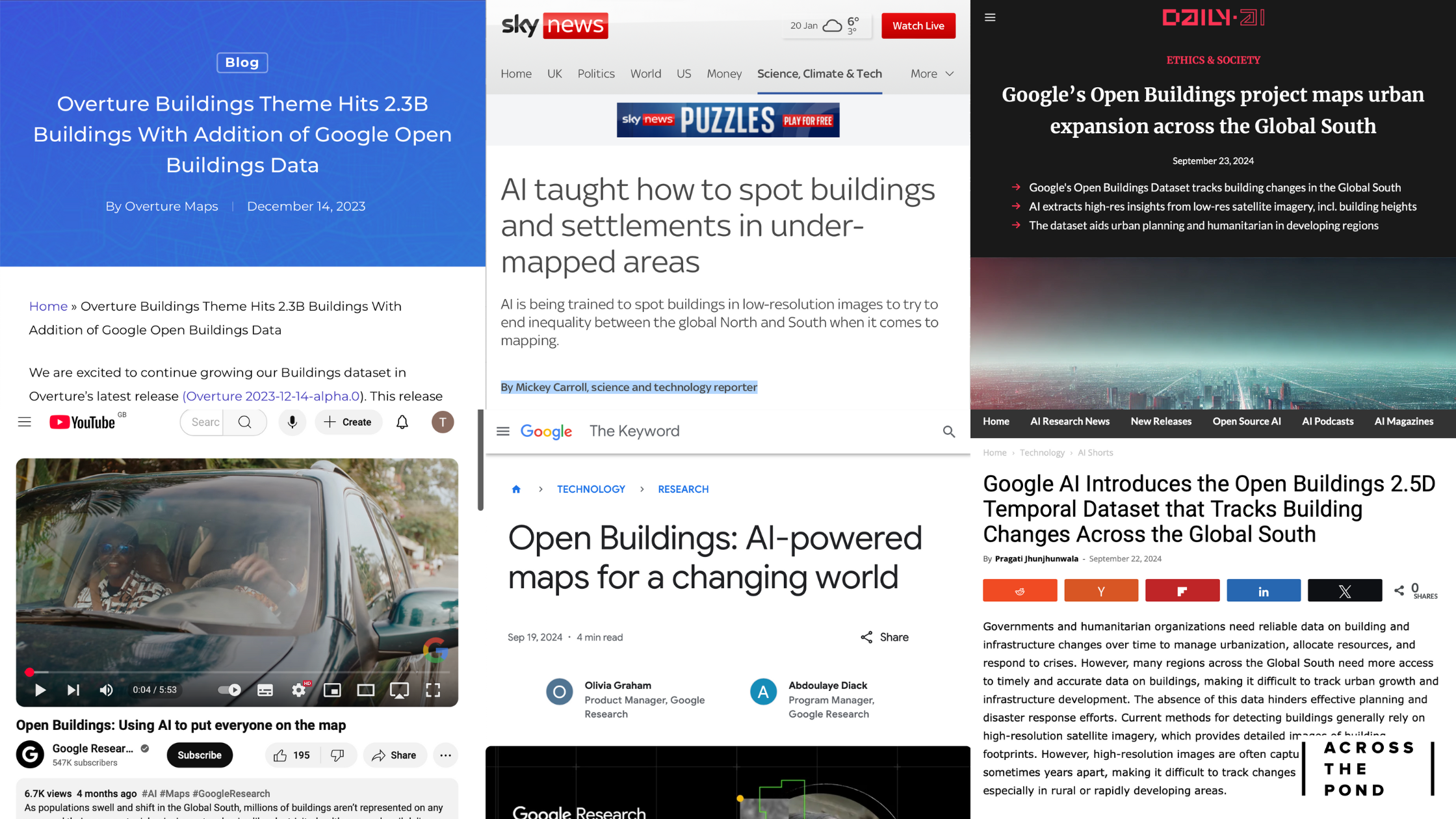NEW WORK ⭐ Google Research Open Buildings: Using AI to put everyone on the map
The invisible layer of visibility: Maps. “Simply put, if nobody knows where you live, they can’t offer you the services or support you need.”
This simple statement from Abigail Annkah, a Research Software Engineer at Google Research, encapsulates the critical issue at the heart of the Open Buildings project in the Global South. Visibility on a map is not just a convenience—it is a lifeline, unlocking access to essential services, driving socioeconomic development, and ultimately, saving lives.
In the Global North, the role of Maps is so embedded in everyday life that it often goes unnoticed. Essential services like the national grid, postal delivery, or emergency response operate effectively because they know where people and places are located. Navigation apps save us minutes on our traffic-ridden commute, help us find our new favourite restaurant, or pinpoint a friend’s location so we can share and find each other—all privileges underpinned by detailed and accessible mapping. Since the launch of Google Maps in 2005, the platform has benefited us in functional ways in our daily routines, reinforcing the notion in the Global North that being mapped is simply a given.
In the Global South, significant challenges such as limited access to electricity and high maternal mortality rates are hindered by socioeconomic development and access to essential services. For example, in Uganda, only 24% of the population has access to electricity at home. Additionally, sub-Saharan Africa accounts for 70% of global maternal deaths, a crisis worsened by inadequate infrastructure and a lack of accurate geographical data. Mapping every community could have a profound impact, but achieving this goal is far from straightforward.
In this video, created in collaboration with the Google Research team, we explore the unique challenges of mapping the Global South—where dynamic landscapes, swelling populations, and data gaps have historically impeded progress. We also shed light on how Google’s AI-driven Open Buildings project rises to these challenges through the Google Research team’s innovative thinking, informed by their deep understanding of the communities and the landscapes that they have made their homes. The result? An AI-driven open source platform, with a tangible, positive impact on human lives.
Open Buildings: A story grounded in communities and landscapes.
The Challenge: Bridging the Map Gap Through Storytelling
At Across the Pond, we worked with the Google Research team to create a video that:
Transforms the Perception of Mapping:
The video looked to emphasise the transformative potential of mapping, shifting the perspective from a navigational tool to an essential resource for sustainable development and equitable growth in underserved communities.
Addresses the Open Buildings Project's Key Issues:
We aimed to highlight the critical issues the Open Buildings project aims to tackle, stressing that without visibility, communities cannot access the support they need. This gap obstructs effective crisis response, urban development, and infrastructure improvement.
Resonates with a Global Audience:
The video needed to connect with both the Global North, who often "take mapping for granted," and the Global South, which has an urgent need for equitable and comprehensive mapping.
Raises the Profile of the Open Buildings Project:
By showcasing the open-source nature of the dataset, the video looked to help raise the profile of the Open Buildings project, and its accessibility to local changemakers, including government agencies and NGOs, to help continue advancements being made using the platform.
Amplifies the Voices Behind the Project:
Highlighting the stories of the people driving the Open Buildings project, including the complex challenges they faced in mapping the Global South in detail.
Explains AI's Role in Mapping:
Demystifying the power of AI in mapping by showcasing how it was applied innovatively to overcome the unique challenges that occurred when accurately mapping these areas.
Transforming the perception of Maps: from a navigational tool, to a driver of transformation.
The Solution: A Visual Journey Through Landscapes and Communities, Told Through the Voices Behind the AI
The Narrative = A Journey.
The video begins with the POV of navigating the landscape in a car using Google Maps, representing the journey of our perception of the platform—from a navigational tool to a driver of transformation. It also follows the journey of, and is narrated by, key contributors to the Open Buildings project: Abigail Annkah, Research Software Engineer, and Abdoulaye Diack, Program Manager, at Google Research. The third narrator is Dr. Ernest Mwebaze, Executive Director at Sunbird AI. His story highlights the platform's role in advancing local infrastructure through collaborations with NGOs, in areas that have benefitted from the mapping data provided by Open Buildings. By portraying the journey behind the creation of Google Research’s Open Buildings Project and grounding it in human experiences, the video makes the development and application of this AI model more relatable and accessible. It resonates with diverse audiences while showcasing the critical role of local expertise in driving the project’s success.
The result: A visual journey through landscapes and communities, told through the voices behind the AI.
Visually Representing the Complexity of Mapping, and the Symbiotic Nature of Communities and Their Habitats:
Sweeping shots of landscapes, informal and urban settlements, and daily life showcase the diverse and dynamic environments of the Global South, and the complexity of mapping ever-evolving life.
Explaining AI through accessible visuals: closing the gap in high resolution satellite imagery.
Explaining the Role of AI Through Accessible Visuals:
Simple animations demonstrate the logic behind how Open Building’s AI model was able to address the gaps in data, such as outlining buildings in informal settlements, and using layering techniques to enhance mapping accuracy in the absence of high-resolution satellite imagery.
Highlighting Tangible Impact Through Case Studies:
The video shows how the dataset enabled SunBird AI to deploy solar mini-grids, illustrating the already tangible impact of the Open Building project on areas within the Global South.
Connecting AI to People and Places:
The narrative humanises AI by tying its impact to the lives and environments of those in the Global South, countering perceptions of AI as distant, impersonal, and reserved for large corporations in the Global North.
Google Research: Open Buildings - Using AI to put everyone on the map, earned media and engagement.
The Result:
Of the video:
Encouraging Adaptation and Replication:
The video breaks down the application of the Open Building dataset, showcasing how innovative methods can help NGOs and changemakers leverage open-source data to address local challenges.
Engagement and Reach:
Engagement with the video has inspired the creation of case studies and blogs detailing the project’s impact.
Earned Media and Awareness:
Media coverage and online discussion generated through earned media helped increase visibility and recognition of the initiative.
Humanising AI-Driven Technology:
The initiative succeeded in portraying AI-driven technology as a human-centered solution, shifting perceptions and making it more relatable for local communities.
Visual Representation of Human Impact:
A powerful visual representation of how AI-driven initiatives, like those supported by Google, are directly impacting communities, enhancing the project’s emotional and social appeal.
Positioning Google as a Social Innovator:
The project helped to portray Google’s position as a leading innovator in social good, advancing both technological development and community-focused solutions.
New Ways of Thinking About Tech's Role in Communities:
Shedding light on this initiative sparks fresh perspectives on how technology can support and uplift local communities, particularly in the context of data-sharing for social impact.
Solar Powered Mini-Grids in Uganda, made possible by Sunbird AI using the Open Buildings dataset.
Of the project:
Data for Local Organisations and Policymakers:
The initiative provided valuable data that can be used by local organisations and policymakers, enabling better-informed decisions and sustainable development.
Technological Advancement in Target Areas:
The Open Buildings dataset facilitated technological advancements in the regions it covered, helping local communities overcome various challenges.
Support for Local Communities:
The project contributed to improving the challenges faced by local communities, with real-world impact seen through enhanced infrastructure, support for growth, and community empowerment.
“Sometimes reality is too complex. Stories give it form.” - Godard
At Across the Pond, our mission is to make the complex, human. This ethos permeates every scene and layer of this Open Buildings creative communications project, and is fundamental to its success. We’re thrilled to have collaborated with the Google Research team on telling the story that sits at the heart of the Open Buildings AI-driven project, shining a light on the human element, both through the first-hand experiences of the key contributors, Annkah, Diack, and Mwebe, and through the positive social impact it had on the communities that were put on the map through the initiative. In such a multi-layered, complex undertaking, distilling the technology into journeys and lived experiences that are grounded in communities and landscapes gave Open Buildings a form for audiences to understand and resonate with the initiative.
To uncover the story at the heart of your initiative, and drive results, contact us at hello@acrossthepond.com.





